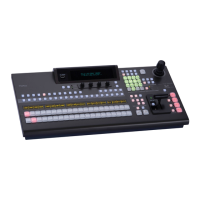73
8-7. Pattern (WIPE/DVE) Transitions
Pattern transitions are available for Background, KEY1 and KEY2.. This section explains how to
perform pattern transitions.
(1) Select a next background video on the PST bus. Before performing a KEY1 or KEY2
transition, perform keyer setup.
(2) Press BKGD, KEY1 or KEY2 in the NEXT TRANSITION section to select a bus to be
transitioned. A simultaneous transition of these three buses is also possible. (See section 8-6.
"Simultaneous BKGD and Key Transitions.")
(3) Press WIPE in the TRANSITION TYPE block.
If the WIPE button does not light up...
There are no free channels for WIPE or DVE transitions. In such case, cancel another
WIPE or DVE setting by selecting MIX for the bus, and then press the WIPE button again
for the desired bus. See the previous page for pattern selection limitations.
(4) Press the PATTERN button to display the [WIPE PATTERN] menu. Select a disired pattern
for the bus using F1 to F3. The patterns can be selected using the Direct Pattern function.
See section 8-8. "How to Select Patterns" for details.
(5)Users can modify the pattern here to add a border, change the aspect ratio, change the start
position and so on. (See section 9. "Modifying Patterns. ")
(6) Set the direction of transition using the direction buttons (NOR/REV and REVERSE).
Transition direction RON/REV button REV button
Always Normal Unlit Unlit
Always Reverse Unlit Lit
Normal at Normal/Reverse operation Lit Unlit
Reverse at Normal/Reverse operation Lit Lit
Transition Rate
The AUTO transition duration (Transition Rate) can be set in the menu.
See section 8-10-2. "Transition Rate."
Fader Limit
When performing transitions there may be times when you want the transition to the next
signal to only complete to a certain degree instead of fully switching from one picture to
another. In such case, change the Fader Limit in the menu. See section 8-10-1. "Fader
Limit."
(7) Press AUTO or move the fader lever to perform the background pattern transition.
The KEY AUTO buttons are available for KEY1 and KEY2 pattern transitions.

